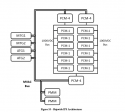Thank you Max for that paper, something interesting to study.
I think you may have mixed the energy with power in case of EMALS, or you mixed the two issues. It deliver 484MJ in 3s, but takes 45s to store that 484MJ from the power grid. The arresting takes few seconds, almost equivalent to the launching. It is the speed of recharging the launcher that makes it a use case, of course that is assuming we are launching and recovering at the same time (aircraft have to rearm, refuel and launch again). This is valuable for both conventional and nuclear CV although I don't know if that scenario is necessary or doable in real combat. For nuclear CV, the recovery of the energy is not necessary.
Before reading the paper, I can say that AC has its own complicity no less than DC, but in different areas. AC is easy to cut off in case some power surge because it has zero point, but it is very difficult to keep frequency and phase sync, the control system would be much more complicated than DC therefor costly. DC's problem is sensing the surge in extreme short time and cut a high current. Prof. Ma has an algorithm with prediction to sense and cut, which is one of the challenges he talked about. Another thing is cutting the current by high power semi-conductor which was expensive some years ago, but not these days. DC high power grid is not more expensive as 10 years ago thanks to the recent fast tech advancement in wind power application, improvement in semi-conductors, and building of national UHVDC network which I think China is the biggest user.
I also want to say that, the presumption of AC IEPS being cheaper is both right and wrong. At the time of its development some decades ago, DC power devices were either expensive or non existence, so it is right to say AC is cheaper because it seemed more realistic. But the presumption overlooked the complicity of the control system, or underestimated it, therefor missed that extra cost. Take Type 45 for example, all ships will have to be added with an extra diesel generator, and even that is just a patchwork that does not address the root cause. I am afraid that solving that root cause will be too expensive for UK, and better to move to DC if they can and have the budget. As for USN, I guess the next IEPS will have to be DC based, be it CV or destroyer.
I think you may have mixed the energy with power in case of EMALS, or you mixed the two issues. It deliver 484MJ in 3s, but takes 45s to store that 484MJ from the power grid. The arresting takes few seconds, almost equivalent to the launching. It is the speed of recharging the launcher that makes it a use case, of course that is assuming we are launching and recovering at the same time (aircraft have to rearm, refuel and launch again). This is valuable for both conventional and nuclear CV although I don't know if that scenario is necessary or doable in real combat. For nuclear CV, the recovery of the energy is not necessary.
Before reading the paper, I can say that AC has its own complicity no less than DC, but in different areas. AC is easy to cut off in case some power surge because it has zero point, but it is very difficult to keep frequency and phase sync, the control system would be much more complicated than DC therefor costly. DC's problem is sensing the surge in extreme short time and cut a high current. Prof. Ma has an algorithm with prediction to sense and cut, which is one of the challenges he talked about. Another thing is cutting the current by high power semi-conductor which was expensive some years ago, but not these days. DC high power grid is not more expensive as 10 years ago thanks to the recent fast tech advancement in wind power application, improvement in semi-conductors, and building of national UHVDC network which I think China is the biggest user.
I also want to say that, the presumption of AC IEPS being cheaper is both right and wrong. At the time of its development some decades ago, DC power devices were either expensive or non existence, so it is right to say AC is cheaper because it seemed more realistic. But the presumption overlooked the complicity of the control system, or underestimated it, therefor missed that extra cost. Take Type 45 for example, all ships will have to be added with an extra diesel generator, and even that is just a patchwork that does not address the root cause. I am afraid that solving that root cause will be too expensive for UK, and better to move to DC if they can and have the budget. As for USN, I guess the next IEPS will have to be DC based, be it CV or destroyer.

